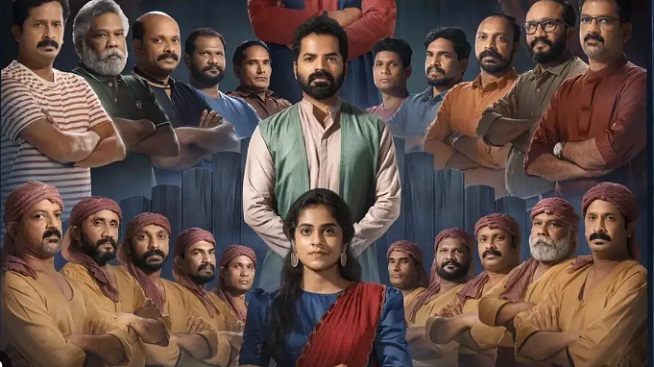Aattam: Astonishingly tense chamber drama that rises above its influences to deliver an incisive, intricate, and nuanced story
The choice to focus the lens on a theatrical troupe feels very intentional: it provides a crucible wherein an assortment of characters from varied backgrounds of economic and social strata can accumulate under one roof, sharing a similar interest. The deliberate decision to also include a sole female within the theatrical troupe allows writer-director Anand Ekarshi to showcase the diversity of the male populace agglomerated under the explicit parameter of masculinity.
Aattam delves into the performative aspect of modern masculinity, which is fragile enough to be exposed or challenged by any form of change or provocation. Ekarshi’s writing stands out for its examination of misogyny. From the beginning of the film, male characters maintain a facade of acceptance and camaraderie, concealing underlying misogynistic attitudes that manifest through subtle microaggressions (for most) and blatant aggressions displayed by Vinay (Vinay Forrt). Vinay is engaged in an illicit relationship with Anjali (Zarin Shihab). His aggressive actions stem from feeling displaced from his central role due to newcomer movie star Hari (Kalabhavan Shajohn), whose presence brings attention and success to a theater group that operates independently but is still influenced by capitalism. This realization leaves Vinay disheartened, as he fears losing the spotlight.
However, when the inciting incident occurs (Anjali being groped at night by one of the members while she is sleeping), with Anjali strongly suggesting she knows the responsible party, Vinay decides to bring in the rest of the troupe to make a decision. Through this meeting, he carefully starts to manipulate so that his ends are met in the process. This is the moment where the movie segues into a chamber drama, and Ekarshi’s minimalistic treatment comes to the forefront.
The script showcases nuanced writing and an exploration of intricate relationships across different generations. As more of the true nature of the men is revealed under the garb of logically questioning the nooks and crannies of that incident, Ekarshi’s choice to sideline Anjali for over 40 minutes becomes remarkably intentional. He effectively makes the viewer feel uneasy as they witness a group of men determining the credibility of a traumatized woman’s account.
Sidney Lumet’s 12 Angry Men (1957; English) can be defined as the gold standard of how a chamber drama is constructed: multiple characters are forced to confront moral and existential questions when faced with an important decision. Unlike 12 Angry Men, where Juror No. 8 works as the conscience of the group, here Vinay works as the mirror image, a manipulator defending and trying to steer the conversation towards “justice,” which would ultimately serve his own selfish ends. But that doesn’t mean Ekarshi lets the other men off the hook. The conversations among all members are incisive without being overt or over-the-top, highlighting central characteristics resulting from class and economic divides within society. It manages to elicit moments of black humour amidst the discomfiture of the men, when faced with the decision to choose a better life or their performative self-righteousness.
Ekarshi also manages to write the character of Anjali and her strength and vulnerability with astonishing depth. Here is a woman severely affected by the events that have occurred, causing her to initially strive to ignore the occurrence. Aattam then delves into her character development, depicting how Anjali gradually lets go of the respect and friendships she had built with her colleagues over 15 years in the troupe. She realizes that male allyship has been replaced by opportunistic tendencies, hiding under a mask of convenience and diplomacy, that push for compromise instead of decisiveness. This depicts Ekarshi’s skillful navigation of societal critique and personal growth within the confines of the narrative. The pressure cooker of the situation threatens to boil over in a breathtaking climax, revealing the inherent flaws of all the men. It exposes all their laughable insecurities and chauvinism in one fell swoop.
Few films can boast of having nearly flawless performances from the entire cast. Aattam is one of those rare films, which also has impressive pacing, effective blocking and staging, and a minimal background score to allow the diegetic score to immerse the audience. One critique of this movie is its slow buildup; however, this deliberate approach ultimately enhances the tension and impact of subsequent dramatic moments. One can legitimately criticize the use of slow motion in some instances of the film, as well as some of the wrinkles introduced for some of the supporting characters, which don’t feed into the overall narrative.
Movies depicting and questioning the perspectives of one single incident and the conflict stemming from this questioning rely heavily on the execution of the climax and its subsequent denouement. The ending of Aattam not only circles back to the theater, where the movie began, but also to the theatrical nature of storytelling itself, where ambiguity could be expressed by the obvious nature of the performance (the white mask shielding all the faces of the men, making them all an agglomeration of the insecurity of masculinity). It allows the film to answer the question being raised without utilizing the obvious method of revelation inherent to a whodunnit.
Ekarshi makes the skillful choice to not dismiss or diminish the woman’s trauma in search of a revelation. It’s this renewed focus on addressing important issues and striving to maintain its complexity that elevates Aattam beyond simply being a product of its obvious 12 Angry Men influences and making it a standout movie of its own—at once modern and yet classical in its temerity.






Leave a Reply
You must be logged in to post a comment.